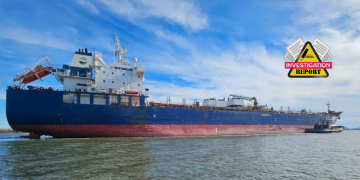Capt. Yves Vandenborn, AFNI, Director of Loss Prevention at the Standard P&I Club, addresses the ISM Code. 20 years after the Code came into effect in 1998, Mr. Vandenborn examines the course of it and what needs to be done in order to become more effective.
The International Maritime Organization (IMO)’s Guidelines on Management for the Safe Operation of Ships and for Pollution Prevention (ISM code) first became mandatory in 1998. Twenty years and five amendments later, we reflect on how the code is doing and what still needs to be done.
Background
The ISM code was born out of a series of serious shipping accidents in the 1980s, the worst of which was the roll-on roll-off ferry Herald of Free Enterprise which capsized at Zeebrugge in March 1987, killing 193 of its 539 passengers and crew. The cause of these accidents was a combination of human error on board and management failings on shore. The Herald of Free Enterprise public enquiry report concluded that ‘From top to bottom the body corporate was infected with the disease of sloppiness’.
What followed was a much needed change in maritime safety administration. In October 1989, the International Maritime Organization (IMO) adopted new Guidelines on Management for the Safe Operation of Ships and for Pollution Prevention giving operators a ‘framework for the proper development, implementation and assessment of safety and pollution prevention management in accordance with good practice’. Following industry feedback, the guidelines became the ISM code in November 1993 and were incorporated in a new chapter IX of the IMO’s 1974 International Convention for the Safety of Life at Sea (SOLAS) in May 1994, and became mandatory for companies operating certain types of ships from 1 July 1998.
Meeting the requirements of the code is evidenced by ships’ flag states in five-year ‘documents of compliance’ for ship operators and five-year ‘safety management certificates’ for ships, both of which are subject to regular audits.
Industry impact
The ISM code requires nearly all the world’s ship operators to write and implement on-board safety management systems (SMS) for their ships and make a ‘designated person ashore’ responsible for every ship’s safe operation. For many shipowners and operators, ISM was simply a new legal framework for the safety systems they already had, but for others, it led to major and much-needed changes in operating culture and organisation. It forced companies with poor or weak management systems to create a formal, structured safety management process for the first time – even if they saw it as just more ‘red tape’.
Certainly, the ISM code has made shipping safer and cleaner over the past two decades. In 2005, the IMO maritime safety committee asked for a report on the impact of the code from an international group of experts. Based on the data collected, the group concluded that ‘where the code is embraced as a positive step toward efficiency through a safety culture, tangible positive benefits are evident’.
The Standard Club has been assessing members’ management systems since 1993 through our member risk review programme. Linked to our ship risk review programme, the review was formerly based on our ‘minimum operating standards’, but since 1998, it has focused (among other things) on how ISM requirements are being met from the perspective of a liability insurer.
As such, we have seen at first hand the many positive changes the ISM code has brought to the marine industry. Most of our members are now using ISM effectively to increase safety on board their ships. This includes creating safe working practices and working environments, making suitable safeguards against potential risks and continuously improving the safety management skills of personnel, as well as the development of emergency response plans for both safety and environmental protection.
Room for improvement
But despite its success to date, we believe there is still scope for our members to improve the effectiveness of ISM.
Producing more effective
SMS documentation One issue we have noticed is the tendency for SMS documentation to be too long. Making it bulky and difficult to read defeats its purpose – it should be short, simple and easily understood. In addressing this concern, we have witnessed a number of our larger members carrying out major reviews of their systems to reduce the volume of text and replace it with flow charts, diagrams and other visual signs to assist quick reference.
SMS documentation should also be unique to the ship, even if it starts life as a standard, ‘off-theshelf’ manual. There is no point, for example, in having tanker procedures in an SMS for a dry bulk cargo ship or having pre-departure checks for bow thrusters where none exist.
A key point to note in drafting SMS checklists is that they should balance the need to remind crewmembers what to do and instruct them step-by-step on how to do it. This will help make ISM more than just a paper exercise. However, the longer the checklists, the less likely they are to be followed properly.
Furthermore, new procedures and checklists should not be added to an existing SMS without properly reviewing older procedures – and removing or consolidating them as necessary. This will ensure there is no duplication or contradiction.
Finally, the SMS documentation needs to be readily accessible to both office staff and crewmembers on board. Crewmembers should know exactly where the documentation is on a ship and how they can quickly find the procedures and checklists they need.
Take a sensible approach to near-miss reporting
We are aware that ISM has prompted some shipowners to encourage an over-the-top approach to reporting near misses and non-conformities in the mistaken belief this alone will improve safety. This method has also been encouraged by major charterers in the wet and dry trades.
As Capt Nippin Anand argues in the next article, there should be no minimum target set for the number of nearmiss reports. The focus should be on learning from genuine near misses and non-conformities. Creating paperwork for these incidents is of little value if the lessons learnt are not built
into training programmes and new safety projects.
Near-miss reports should be analysed and categorised so they can be combined with reports from other ships in the fleet. They should also be cross-referenced with similar statistics and categories from port state control (PSC) inspections, oil major inspections (SIRE) and Rightship inspections.
Any category standing out in key performance indicators (KPIs) needs further analysis. Lessons learnt should be incorporated into the next quarterly or yearly training programme. A real incident is less likely if such steps are taken.
Value ISM review reports
We also believe shipowners and operators should pay more attention to their masters’ SMS review reports.
The 2008 update to the ISM code made masters responsible for ‘periodically reviewing the SMS and reporting deficiencies to shore-based management’. In our experience, these vital reports are very often incomplete (or say everything is satisfactory) and certainly are not dealt with properly.
Masters should be encouraged to discuss the SMS reviews with crewmembers as they are the key users of the documentation and should have the biggest input into any proposed changes. The reports should be a priority for senior management, as failure to act on what their masters tell them could lead to a major casualty or major ISM non-conformance.
Senior management should give similar attention to ship safety committee meeting reports (SCMR), which are a requirement under the International Labour Convention. These too are often not filled in properly, particularly if the meetings focus on welfare issues rather than safety.
Conclusion
In summary, masters and crew need to be educated in what the SMS reviews and SCMR are for, and how best to conduct discussions and meetings prior to writing their reports. Equally, shore-based managers and staff need to know how to review the reports properly and, more importantly, how to improve the safety of their ships as a result.
By Capt. Yves Vandenborn, AFNI, Director of Loss Prevention, Charles Taylor Mutual Management (Asia) Pte. Limited, Managers of The Standard Club Asia Ltd.
Above article has been initially published in Standard Club’s publication ”Standard Safety” and is reproduced here with author’s kind permission
The views expressed in this article are solely those of the author and do not necessarily represent those of SAFETY4SEA and are for information sharing and discussion purposes only.































































As DPA, internal audit certified, though nonetheless remain in a senior officer capacity aboard my vessel without such knowledge of my certification being known to the office, subsequently have remained I a position to observe countless infractions by both supervisors and office management personnel alike. Understanding the objectives of ISM (IX) SOLAS remains an impediment to the phycological, cultural imperative state of mind that seemingly cannot be undone by centuries of practice by said institutions.
Thus, I’ll remain behind the curtain for the time being.